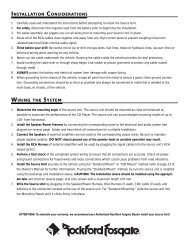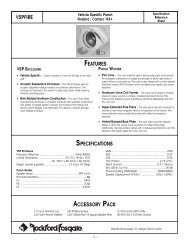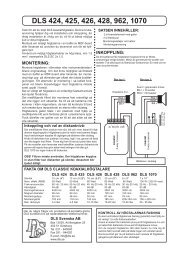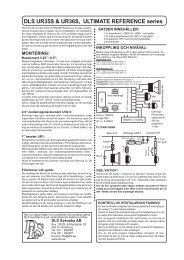Small Room Acoustics De-Mythologized - Eporia
Small Room Acoustics De-Mythologized - Eporia
Small Room Acoustics De-Mythologized - Eporia
You also want an ePaper? Increase the reach of your titles
YUMPU automatically turns print PDFs into web optimized ePapers that Google loves.
®Standing waves arise when two reflective surfaces on opposite sides of a room are paralleland a sound source is between them. At certain well-defined frequencies, the incidentsound wave at a surface will reflect back and interfere with itself causing a stationarypattern of low and high sound pressure levels. See figure 4.With perfectly reflecting walls, the minima would be zero sound pressure, or negativeinfinity dB SPL, but ordinary walls do not cause complete cancellation, and the minima areonly down about 10 to 30 dB. Note that a set of standing waves will exist which areintegral multiples of the frequency where one half wavelength is equal to the wall spacing.The behavior of parallel walls is similar to what happens in an organ pipe. These standingwaves are also known as room resonances. A good familiar example of a strong standingwave is the tiled shower stall. If the height is 7 feet, the lowest frequency which will bereinforced at the ceiling and floor is about 80 Hz, which is within the fundamental frequencyrange of most male voices. The nearby side walls keep the sound energy confinedin the stall, increasing the loudness, and the position of the head near the ceiling means thepressure increase due to the standing wave is heard. This strong reinforcement of thelower voice range is a powerful inducement for some people to sing!A rectangular room with smooth hard surfaces will have three sets of standing waves, andif the dimensions of the room are equal (a cubical room), all the resonances will overlapand reinforce each other. If the dimensions are commensurate (having a least commondenominator), then some of the resonances of the three sets will have the same frequencies,and will reinforce each other also. This increases the non-uniformity of distribution ofsound in the room, and for this reason non-commensurate dimensions are desired formusic listening rooms.Note from figure 4 that all standing wave patterns have maxima at the room boundaries.Note also that if one listens at any location where there is a minima, that particular standingwave will not be heard, or at least will be heard at a much lower level.Standing waves in rooms are a form of room resonance, and their location and frequencyare precisely determined by the room dimensions, not by the source of the sound. Their“strength”, or magnitude depends on the sound absorption characteristics of the roomboundaries. If the boundaries are very absorbent, the standing waves will be very weak,and probably not noticeable at all. On the other hand, if the boundaries are very reflective,such as concrete or smooth plaster, the standing waves will be very prominent. Mostcommon surfaces in music listening rooms have significant absorption, especially at thehigher frequencies. For this reason, standing waves at high frequencies are seldom if ever aproblem. At low frequencies, however, two things conspire to make standing waves veryannoying to the music listener. One is the fact that the wavelengths are fairly long. Forinstance, at 100 Hz, the wavelength is about 10 feet, and standing wave maxima are thusabout 5 feet apart. Contrast this to 10 kHz, whose wavelength is about an inch, withstanding wave maxima spaced only about a half-inch apart. The widely-space maxima andminima of low-frequency standing waves are what give a small bad room its non uniformity.6
















